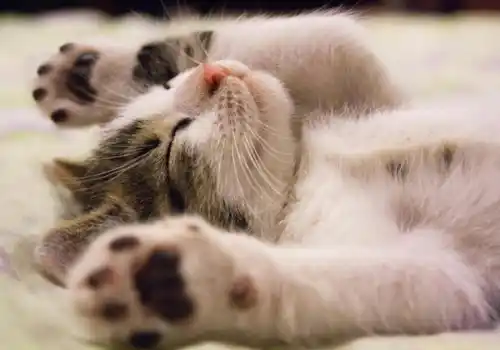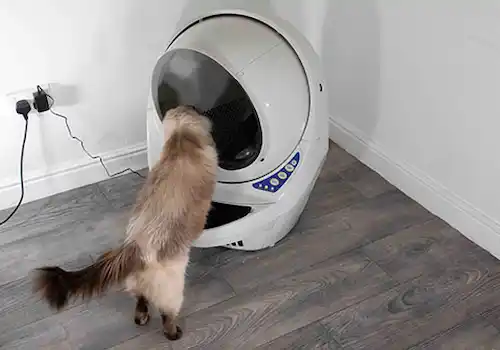Feline infectious peritonitis (FIP) is a very difficult disease to deal with as it's hard to diagnose and treat.
What causes FIP?
FIP is a disease that develops only after cats are infected with feline coronavirus (FCoV). We’re, sadly, all too familiar with the coronavirus group of viruses but FCoV is very different to COVID-19. Most strains of animal coronavirus only affect one species (steering well clear of humans). FCoV is no exception to this and only infects cats.
FCoV is actually a very common infection affecting up to 50 per cent of household cats. For cats living in big groups, such as multi-cat households, the infection rate is over 80 per cent. It can be scary finding out that your cat has FCoV but having the virus doesn’t mean they have FIP. In fact, most cats with FCoV never go on to develop full-blown FIP. FCoV usually causes no symptoms at all or just mild diarrhoea that gets better without treatment.
There are two main reasons why some cats with FCoV develop FIP and some don’t:
- The virus mutates into a harmful form once inside the cat
- The cat’s immune system launches a certain kind of defence against the mutated virus resulting in FIP disease.
How is FCoV spread?
FCoV spreads via the oro-faecal route, which is basically poor toilet hygiene! Cats with FCoV pass virus-laden faeces into the environment for a few weeks to months. Other cats sharing the same toileting area or litter tray then lick the virus from their paws becoming infected themselves.
Cats living in close contact with others (in breeding colonies or multi-cat households) are more likely to spread FCov as they share toilet facilities. Strangely, the virus doesn’t transmit directly from cat-to-cat but survives long enough in faeces to be highly contagious.
Cats living alone can still develop FIP if they had FCoV during kittenhood. The virus remains dormant for months or years before mutating to cause disease. Stressful events or illnesses affecting the immune system can trigger the virus to ‘wake up’ and cause FIP.
What are the signs of FIP?
Most cats develop FIP as a youngster with many cases affecting kittens less than a year old. The symptoms each cat has depends on where in the body the virus is attacking and what kind of defence the immune system launches.
Vets have always referred to FIP as either ‘wet’ or ‘dry’. These terms are a simplified way of describing how the cat’s immune system is fighting the virus. The ‘wet’ version is when fluid fills the cat’s chest or abdomen. This happens because the virus damages blood vessel walls and they become leaky. Inflammatory fluid within the abdomen is called peritonitis, hence the name of the disease, feline infectious peritonitis.
The ‘dry’ form is when inflammation affects the organs without fluid. Granulomas (masses of cells) form within organs causing serious problems. They often affect the eyes and brain but can develop elsewhere too.
In reality, cats usually get both wet and dry FIP, either at different times or together. The wide range of often vague symptoms makes diagnosing FIP a challenge.
Early symptoms include:
- Fever (high temperature) that comes and goes.
- Lethargy.
- Reduced appetite.
- Weight loss.
- Loss of condition.
- Gastrointestinal upsets (usually diarrhoea).
As the disease progresses, cats may show more specific symptoms including:
- A bloated abdomen (seen with the ‘wet’ form).
- Breathing difficulties, especially if fluid presses on the lungs.
- Neurological problems (cats become wobbly or have seizures if the ‘dry’ form affects their brain-this is called neurological FIP).
- Eye problems or even blindness (ocular FIP).
- Jaundice (a yellowy tinge to gums, skin and the white parts of the eye).
Diagnosing FIP
There isn’t one specific test for FIP so your vet will need to run a few checks before they can diagnose it. An essential part of any vet’s investigations is to take a history. This involves asking questions about your cat’s lifestyle and general health. For FIP, this is very important as cats who are ‘high risk’ (such as young cats living in large groups) are more likely to develop the disease.
Blood tests
These are usually the first diagnostic step and typical changes seen with FIP include:
- White blood cell abnormalities.
- Changes in globulin (protein) levels.
- High liver enzymes (enzymes released into the blood if the liver is diseased or damaged).
- High bilirubin (a waste product from the liver that can cause jaundice).
Remember healthy cats can have antibodies (disease fighting cells) to FCoV in their blood. Finding them doesn’t mean your cat has (or will get) FIP.
Fluid
Vets can take samples of fluid from a cat’s chest or abdomen for analysis (the fluid commonly seen with the ‘wet’ form of FIP). They collect the fluid by inserting a small needle into the cat’s body and sucking out the liquid with a syringe. Vets use an ultrasound scanner as it allows them to accurately collect the samples while checking your cat’s major organs at the same time. A laboratory will analyse the fluid and check whether the virus is present by running a PCR test (many of us had PCR tests to diagnose COVID).
Other tests
Depending on your cat’s symptoms, they may need tests that target specific body parts:
- An MRI scan looks for changes within the brain.
- An ophthalmic (eye) examination shows abnormalities within the eye (samples of eye fluid can be analysed too).
- Biopsies (samples of tissue) from affected organs and lymph nodes (small lumps around the body packed with disease fighting cells).
- Cerebrospinal fluid analysis (fluid from around the brain and spinal cord).
Treatment
Up until very recently, the only treatments available for FIP were palliative (made cats comfortable but didn’t cure the disease). Thankfully, new anti-viral medications have changed that and we have a cure!
The exact treatment your cat will have very much depends on their individual symptoms and also your budget. It’s always difficult considering finances where poorly animals are concerned but it’s a necessary discussion to have with your vet. Cheaper, illegal versions of anti-viral drugs have been available to order online for a while but this is a dangerous route to take. These unregulated medications may contain substances that do your cat more harm than good.
Most cats begin their treatment of anti-viral medication with daily injections before moving onto daily tablets. They’ll need treatment for around 84 days (it’s a big commitment for you too!) If your cat is very unwell, they can begin their treatment as an inpatient at the vet’s. They may need intravenous fluids and help feeding too.
During their treatment, your cat will need regular vet checks and a weekly weigh-in. Your vet will adjust their dose if they gain weight to make sure the medication is still effective. Regular scans and blood tests will show how well your cat is responding to treatment and whether they need any additional help.
Most cats (over 85%) go into long-term remission after their treatment ends. These results are truly incredible for what was once a fatal disease!
Can you prevent FIP?
Preventing the spread of FCoV is difficult and outbreaks sometimes occur despite your best efforts. Some measures that can help include:
- Scrupulous litter tray hygiene — disinfect them at least once a day
- Having ample trays available — one tray per cat plus an extra (if this is too many then at least one tray for every two cats).
- Keeping cats in small, stable groups — less than four is ideal.
- Avoiding stress where possible — some stress (such as vet visits) is unavoidable but try to reduce unnecessary activities.
Vaccination
A vaccine is available (not in the UK) but it’s unsuitable for young kittens. By the time kittens are old enough to have the vaccine, most have been exposed to FCoV anyway. Hopefully, in the future, a more suitable vaccine will be more widely available.
Adopting a cat
If you’re rehoming a cat or kitten, ask the breeder or rescue centre about the health of their other cats and previous litters. If in doubt, ask your vet for advice before you commit to the adoption.
Want more cat health advice like this?
Sign up to our FREE weekly newsletter for further cat health advice, tips, competitions, latest news and updates, plus much more, straight to your inbox! Sign up here.







